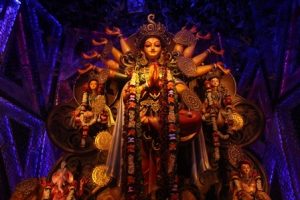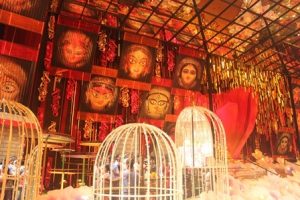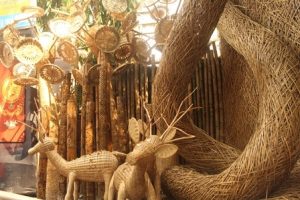Looking Back At the Best Durga Puja Moments in Kolkata
As the city awaits the arrival of another Durga Puja next year, we take a look at a few of the best moments from Kolkata’s biggest festival in 2019.

The month of October is almost drawing to a close. It has now been a while since Durga Puja came to an end for the year. The streets have denuded its decorations, the city lights have been taken down from all the roads, lanes, buildings and bridges, the lone pandal now stands awaiting to get dismantled until it is put up once again in another such Puja and idols have been long immersed into the water bodies.
Vacations are over and the streets are full of people once again. However, the crowd this time is not the enormous wave of people waiting to catch a glimpse of their favourite Durga pujapandal but individuals who have returned to the hustle-bustle of their daily lives after the festive season.
Also Read : Kolkatas Kumortuli Where Idols Come To Life
It is perhaps that time of the year when the city of joy seems to be covered in a subtle veil of sadness. The puja season for the year is over but it has surely left behind a few of the most amazing memories to cherish for another year. As the city awaits the festive season to arrive next year, Delhi Post looks back at some of the best Durga Puja moments in 2019.
Mahalaya: The Beginning

Over the years, various traditions associated with Durga Puja have changed and evolved into something modern and new. However, the culture of tuning in to Birendra Krishna Bhadra’s Mahishashura Mardini at 4 am in the morning remains the same in numerous Bengali households even today. As he recites the story of Mahishashura’s defeat in the hands of Goddess Durga and the triumph of good over evil in the two-hour-long programme, the Bengali heart soaks in the warm feeling of the beginning of their biggest festival. Mahalaya marks the start of Devi Durga’s journey to her ancestral home and declares the inception of Devi Paksha that continues till the end of Durga Puja.
Shopping Hotspots
Durga Puja is one of those festivals that compel the entire city to step into a massive shopping spree. Months before the festival, almost every individual is in a frenzy to get their hands on new clothes, accessories and apparels. The age-old custom of gifting the best one can provide to their loved ones as well as themselves during the festival is still a constant.
As Puja inches closer, shopping malls, general shops and hawkers are flooded with customers. The sellers undoubtedly mark this time of the year as the peak season for their business with maximum sales and extreme hard work!
Amidst the innumerable options available these days, certain areas in the city stand as the biggest hotspots for Puja shopping. Gariahat in South Kolkata and New Market in North Kolkata are considered to be the biggest shopping arenas in the city. From traditional outfits to western wears, these places provide all kinds of clothing items and dress materials. From street vendors to posh malls, the shopping opportunities and price range is largely variable. Places like Dakshinapan, Shyambazar, Hatibagan, Burrabazar, Vardhan Market among others are also well-known areas for Puja shopping.
Despite numerous options of almost every kind of clothing items and accessories in these places, nowadays a lot of people tend to depend on online shopping. However, the vendors are of the opinion that the culture of shopping in person remains the same. Nitai Pal, a ladies clothing hawker from Gariahat, said, ‘Online options does not affect our sales. In fact, this year, we had the maximum number of customers of all time. Puja is our season! People still prefer to select products by themselves, especially from these large options and great discounts’. ‘Puja is our season to shine. This year our maximum revenue so far has arrived during the time of Puja shopping. The crowd only increases every year’, shared Azaan Wasim, a unisex garment shop owner from New Market.
Pandal Hopping

Perhaps the most interesting aspect of Kolkata’s Durga Puja is the tradition of pandal hopping. Every year numerous pandals (marquee house designed for the idols of Goddess Durga and her children) are built and decorated with utmost creative independence. The amalgamation of traditional pandals and idols as well as those based on a respective theme turns the city into a pot of magnificent art and culture. The graph of the presentation only goes higher every year and this time was no different. The routes to the most prominent pujapandals were once again segmented into North Kolkata, Central Kolkata and South Kolkata.
One of the most talked-about pandals this year was Santosh Mitra Square in Central Kolkata. With an exterior resembling the grand ISKCON temple and an interior influenced by Jaipur’s Sheesh Mahal, the idols were adorned with 50 kilograms of gold, worth nearly 20 crores.
Similarly, the Young Boys Sarbojanin Club from the same area aimed to pay homage to the Balakot Airstrikes through their theme. College Square, also from Central, grabbed eyeballs with the replica of Jodhpur’s Umaid Bhawan with an actual lakeside setting and light work illuminations.
North Kolkata has been mostly known for its traditional ways of celebrating the festival. Few of the most prominent ‘Shabeki’ or traditional pujas in Kolkata are found in North Kolkata. But, over the years, many pujas have also embraced various theme-based pandals. Few such remarkable pujas from the North this year was Kumartuli Park’s insight into the intergalactic world of space with a makeshift rocket launcher, Telengabagan’s rebirth theme with a pandal that had a 40ft long ceiling and emblems of various Hindu gods, Ahiritola’s focus on water scarcity and conservation, Kashi Bose Lane’s theme of survival and Tala Prottay’s theme of bring poetic imagination and vision to life.
South Kolkata also has its share of traditional pujas but this part of the city has always been famous for its creativity and innovation. This year, the creative quotient was no different and it resulted in introducing a few of the most unique pandals around the city. Hindustan Park explored the nine emotions of humans, Tridhara Sammilani showcased the theme of perspective. Meanwhile, Adi Ballygunge Sammilani brought to light a theme based on the abolition of Section 377 and equal rights for all and Rajdanga Naboday Sangha focused on the life and struggles of refugees. On the other hand, Khidirpur 25 Pally built their pandal around the theme of the adverse effects of pollution and the famous Suruchi Sangha created a theme based on various festivals built around the backdrop of a traditional Bengali household from the past.
Also Read : Shanti Mallick A Rebel Who Embraces Hardships
The city also witnessed some ethic and age-old Durga Puja in royal and zamindar houses. The notable ones in this category are Sobhabazar Rajbari Puja, Mallick Bari’s Puja, Jorasanko’s Dawn Family’s Puja, Bowbazar’s Chandra Bari Pujaand the Durga Puja of Rani Rashmoni’s House among similar others.
Visarjan: The Climax
After three days of endless celebrations, the city arrives on the 4th and final day of the grand festival, also known as Bijoya Dashami. With a tinge of sadness, the Bengali heart waits to bid adieu to Goddess Durga. The day begins with the tradition of ‘Debi Boron’ as the married womenfolk offer sweets and sindur to their Maa Durga. Later, people take part in the auspicious custom of ‘Sindur Khela’ or the vermillion game by smearing sindur on one another. They also engage in the traditional ‘Dhunuchi Nach’ along with the steady rhythm of the Dhak (Drum).
The final moment of goodbye to goddess Durga and her children begins through the custom of ‘Bhashan’ and ‘Bisorjon’ or the immersion of the idol. The process is carried out with as much pomp and grandeur as the festival itself. The major places of immersion in Kolkata are mainly the River Ganga and BagbazarGhat.
As the idols slowly immerse into the ebb and flow of the water bodies, the entire city chants ‘Asche Bochor Abar Hobe’ (See you again next year), awaiting her return back home in the forthcoming year.
